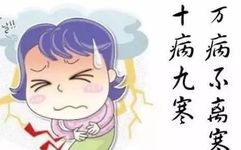The Six Qi
The Six Qi refers to the six normal climatic factors in nature: Wind (Feng), Cold (Han), Heat (Shu), Dampness (Shi), Dryness (Zao), and Fire (Huo). Under normal circumstances, these six factors are essential for the growth of all living things. Humans have adapted to these six factors over a long evolutionary process, so they are generally harmless to the body.
The Six Evils, or Liu Yin, is a collective term for the six external pathogenic factors: Wind, Cold, Heat, Dampness, Dryness, and Fire. When climatic changes are abnormal, such as excessive or insufficient presence of these factors, or when they occur out of season (for example, cold in spring or heat in autumn), and when there is a rapid change in climate (such as sudden cold or heat), these factors can become pathogenic, especially when the body’s Zheng Qi (upright Qi) is deficient and resistance is lowered. In such cases, the abnormal six factors are referred to as Liu Xie (Six Evils), which are considered external pathogenic factors.
1. Cold Evil (Han Xie) – Cold has the characteristics of coldness and condensation, being the main Qi of winter. The four solar terms from Minor Snow (Xiao Xue), Major Snow (Da Xue), Winter Solstice (Dong Zhi), to Minor Cold (Xiao Han) represent the main Qi of winter. Cold is associated with water and corresponds to the Kidney (Shen), hence winter is considered the season of cold water. Cold diseases are prevalent in winter but can also occur in other seasons. Additionally, exposure to rain or water, or sweating in the wind, are common causes of Cold Evil invasion.
Characteristics and Pathogenic Features of Cold Evil: Cold Evil is characterized by coldness, stagnation, and contraction.
① Cold easily injures Yang: Cold is a manifestation of Yin Qi, thus it is considered a Yin Evil. Yang Qi can normally control Yin, but when Yin and Cold are excessive, Yang Qi is insufficient to dispel Cold Evil, leading to its invasion. Therefore, it is said, “When Yin is excessive, Cold prevails,” and “When Yin is excessive, Yang suffers.” Cold Evil is most likely to damage the body’s Yang Qi. When Yang Qi is damaged, it loses its warming function, leading to obvious cold symptoms in the whole body or locally. For example, if Cold Evil constricts the exterior, it can cause symptoms like aversion to cold, fever, and absence of sweating, known as “Injury from Cold” (Shang Han). If Cold Evil penetrates internally and damages the Yang Qi of the organs, it is referred to as “Internal Cold” (Zhong Han). If it affects the Spleen and Stomach, it can lead to abnormal digestion, resulting in vomiting, diarrhea, and abdominal pain; if it affects the Lung and Spleen, it can cause cough, shortness of breath, and clear phlegm; if it injures the Spleen and Kidney, it can lead to cold limbs, lower back pain, and edema; if there is Heart and Kidney Yang deficiency, it can cause symptoms like aversion to cold, cold extremities, diarrhea, and mental fatigue.
② Cold nature causes stagnation: Stagnation refers to blockage and obstruction. The movement of Qi, blood, and body fluids relies on the warming function of Yang Qi. When Cold Evil invades the body, the meridians and blood are deprived of Yang Qi warmth, leading to stagnation and blockage, which causes pain. Pain caused by Cold is alleviated by warmth and worsens with cold exposure. Therefore, pain is a significant feature of Cold Evil. The location of Cold invasion can lead to different symptoms. If Cold affects the exterior, it can cause severe pain in the head, body, and joints; if it penetrates internally, it can cause cold pain in the chest, abdomen, or cramping pain.
③ Cold nature causes contraction: Contraction refers to the pulling and tightening nature of Cold Evil. Cold can cause Qi to contract, leading to closed pores and constricted meridians. If Cold affects the joints, it can cause tightness and pain, leading to difficulty in movement; if it affects the exterior, it can cause fever and aversion to cold without sweating.
In summary, Cold is the main Qi of winter and corresponds to the Kidney water. Cold diseases are most prevalent in winter but can occur in other seasons. The pathogenic features of Cold Evil include: being a Yin Evil that easily injures Yang Qi, leading to obvious cold symptoms in the body or locally. Cold causes pain, making pain a significant feature of Cold syndrome. Cold causes Qi contraction, leading to symptoms like closed pores, Qi stagnation, and tightness in the meridians, manifesting as absence of sweating, tightness, pain, or difficulty in movement.
2. Wind Evil (Feng Xie) – The characteristics of Wind Evil include sudden onset, rising, dispersing, and unpredictability. Wind is the main Qi of spring. In TCM, diseases caused by Wind are characterized by the following four features:
● Floating and dispersing: Wind has the characteristic of rising and dispersing, thus it is considered a Yang Evil. The disease manifests as being superficial and easily dispersing, such as symptoms of a cold like headache, nasal congestion, throat itch, cough, aversion to wind, fever, and sweating.
● Good at changing: Wind Evil leads to symptoms that change frequently, such as wandering pain in muscles and joints, or rheumatic arthritis with pain that moves unpredictably.
● Good at movement: Wind Evil has a shaking characteristic, leading to involuntary movements like sudden fainting, dizziness, tremors, convulsions, and facial spasms. Conditions like hypertension leading to stroke exhibit sudden onset and symptoms like facial drooping, which are characteristic of “Wind Stroke” (Zhong Feng). Treatment often involves using Wind-dispelling herbs.
● Often combined with other evils: Wind Evil rarely invades the body alone; it often combines with other external evils like Cold, Dampness, Heat, or Dryness, forming complex pathogenic factors. The manifestations will then exhibit characteristics of both evils. Wind is a major cause of external diseases, hence the saying, “Wind is the chief of all diseases.” In cold weather, exposure to wind can lead to a cold, also known as a common cold.
3. Heat Evil (Shu Xie) – Heat is characterized by its fiery nature, primarily occurring in summer. It is associated with the four solar terms from Minor Full (Xiao Man), Grain in Ear (Mang Zhong), Summer Solstice (Xia Zhi), to Minor Heat (Xiao Shu). Heat Evil often presents with symptoms like high fever, irritability, flushed face, and rapid pulse, known as “Injury from Heat” (Shang Shu).
4. Damp Evil (Shi Xie) – Dampness is characterized by heaviness, stickiness, and a tendency to descend. It is the main Qi of late summer. The four solar terms from Major Heat (Da Shu), Beginning of Autumn (Li Qiu), End of Heat (Chu Shu), to White Dew (Bai Lu) represent the peak of Dampness. Dampness corresponds to the Spleen (Pi) and can cause various diseases throughout the year, often with slow onset and difficult detection.
5. Dry Evil (Zao Xie) – Dryness is the opposite of Dampness and is characterized by its ability to injure body fluids. It can be caused by external factors like dry weather or internal factors like excessive sweating or vomiting.
6. Fire Evil (Huo Xie) – Fire is characterized by its heat and is predominant in summer. It corresponds to the Heart (Xin) and is not limited by seasonal changes. Fire can be classified into physiological fire, which is necessary for life, and pathological fire, which is excessive and harmful to the body.
In conclusion, the Six Evils in TCM represent various external pathogenic factors that can lead to disease. Understanding these factors is crucial for diagnosis and treatment in Traditional Chinese Medicine.
Tang Xiao, TCM Practitioner, wishes everyone good health and peace of mind.


